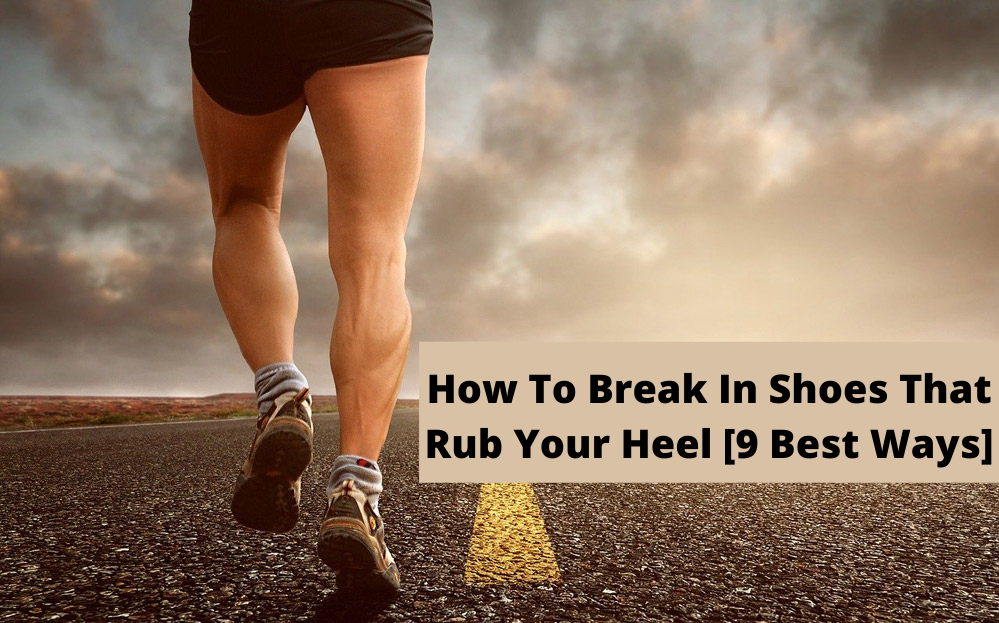A lot of people have trouble breaking in new shoes. To make the process easier, you can try these tips: First, wear your new shoes for a while before deciding if they are too uncomfortable. If they are still tight after some time, stretch them out by bending and flexing them. You can also use shoe stretchers to help with this process. Finally, you could buy insoles that will give more support for your feet and lessen the rubbing against your heel or other parts of your foot that might be sore from wearing new shoes!
Things to remember During the shoe buying stage:
-When you try on shoes, always do so with the socks you plan to wear them with. This will give you a better idea of how the shoes will fit and feel.
-Be sure to buy shoes that are the correct size. A shoe that is too small or too large will not be comfortable to wear.
Try New Shoes With Socks On:
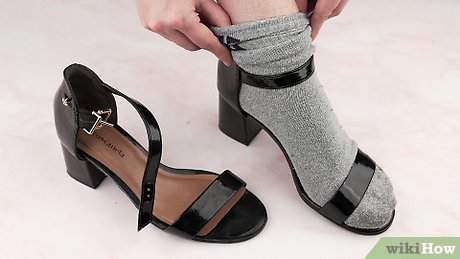
It can take time for a new pair of shoes to break in. The best way to break in a new pair of shoes is by wearing them around the house with socks on. This will help stretch out the shoes and make them more comfortable to wear.
Timing Matters:
The time of year can also affect how well a shoe will break in. A shoe that fits well during the summer may not fit as well when the weather turns colder and thicker socks are worn.
Foot’s Shape and Size:
A person’s foot shape can affect how a new shoe feels after it is broken in. If your feet have an unusual size or shape, you may have to have shoes stretched so they feel more comfortable when you wear them.
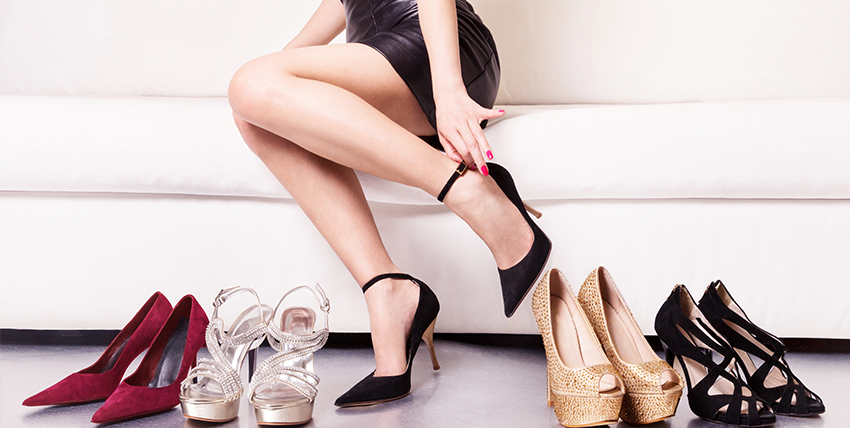
How To Stop Shoes From Rubbing Heel
Do you search for the best way to break in shoes? So, below we will discuss some of the best available methods that will give you a solution regarding breaking in shoes without rubbing heel.
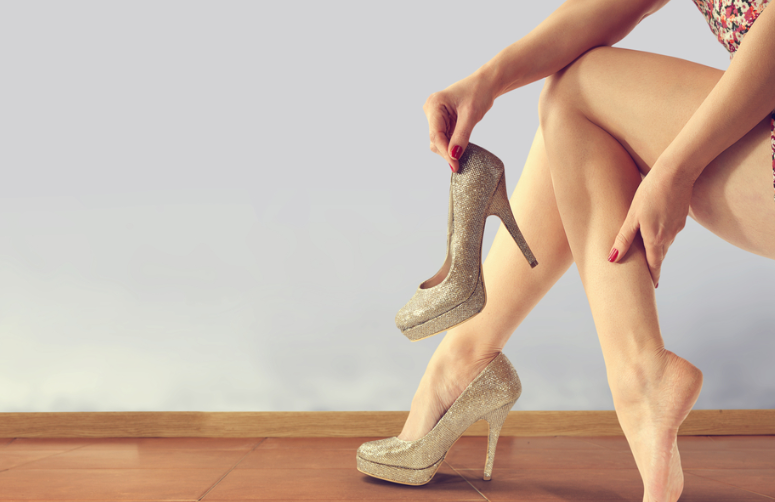
1.
Choose the right pair of socks
2.
Shoe
Stretcher Might Work for Your Heels
3.
Use
Comfortable insoles
4.
By using
Shoe materials
5.
Reduce
the moisture in your shoes
6.
Stretching
your shoes Can Solve the Problem
7.
Cobbler
Can Stretch Your Shoes
8.
Check for
sharp edges
9. Use an Anti-Friction Balm
Now read the explanation of the above-listed hacks/methods for shoes that rub heel carefully so that you will get what you want.
Step 1: Choose the right pair of socks
Socks come in all shapes and sizes, and they can play a big role in how comfortable your shoes feel. If you're trying on a new pair of shoes that are rubbing against your heel, it might help to try them on with a pair of socks that are thicker or have a bit more cushioning. This will help to create a barrier between the shoe and your skin, which can help to prevent any irritation from happening.
Step 2: Shoe Stretcher Might Work for Your Heels
If the shoes you've just bought are really tight around your heel, you might want to consider using a shoe stretcher. This is a small device that you can use to stretch out the material of the shoe, making it more comfortable and less likely to rub against the back of your foot. To find a shoe stretcher, check out a local cobbler or look for one online.
Step 3: Use Comfortable insoles
Insoles are removable liners that you can place inside your shoes to improve the overall comfort level. They provide cushioning and padding that makes it more comfortable to wear your new shoes all day long. Some insoles have arch supports, which help to prevent any pain from happening in the ball of your foot as well as take some pressure off your heels. If you don't see an insert with extra support, there's no need to worry—you can always purchase a separate one and make sure it fits snugly into the shoe.
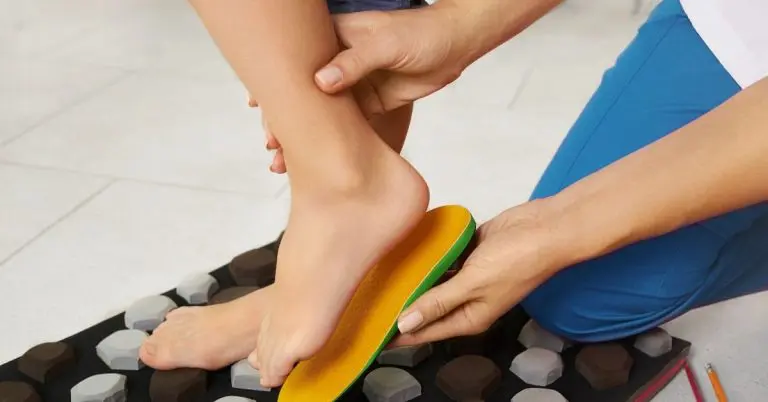
Step 4: Shoe materials
There are a lot of different shoe materials that you can choose from when trying to find something comfortable and supportive for your feet. Shoes made from softer leather might breathe better than those with stiffer uppers, so they're less likely to rub against the back of your legs or get sweaty throughout the day. Aesthetics aside, you should also try to focus on choosing shoes that are breathable and lightweight.
they'll be more comfortable to wear all day, every day. Also remember that high-top shoe styles have extra material around your ankles which can cause rubbing if they don't fit properly. So if possible, opt for low- or mid-height tops instead of anything that reaches all the way up to your shins.
Step 5: Reduce the moisture in your shoes
Unfortunately, some days it might be hotter than usual or you'll do something physical during the day that makes it hard for sweat to escape from your feet. On these occasions, it can't hurt to have a spare pair of socks with you at work—just make sure they're clean! If more cushioning is what you need, try wearing an extra pair of insoles instead of two pairs of socks.
Step 6: Stretching Your Shoes Can Solve the Problem
For those who suffer with stubborn tight shoes, stretching them out can be the key to making it through the day without any issues. If shoes are too small, they can create pressure points around your toes and make it difficult for you to focus throughout the workday. Luckily, there's hope—just follow these steps:
1. Place a shoe stretcher or two inside of your shoe (one on each side).
2. Leave them in there overnight (or for at least 12 hours).
3. Remove the stretchers and wear your shoes as normal—they should feel less tight after this process!
Before trying this trick with new shoes, make sure you've tried them on first and taken note of how tight they are. If they're really struggling to stretch, you might need to use a shoehorn to insert the stretchers properly.
Step 7: Cobbler Can Stretch Your Shoes
If you have a trusted cobbler in your area, he or she might be able to help you out with stretching your new shoes. This is a service that they offer for a fee, and it's definitely worth considering if the shoes are rubbing against your heel severely. Just make sure you take your shoes to them before any damage is done!
Step 8: Check for sharp edges
One thing that can often cause problems with tight shoes is having sharp edges on the inside of the heel cup. These can rub your heels raw without you even noticing, so make sure to take a look around the entire inside of your shoes before deciding whether or not they're worth keeping. If there's any rough material sticking out, it's important to get rid of it before wearing them again—you don't want to suffer from blisters and calluses throughout the workday.
Step 9: Use an Anti-Friction Balm
There are a number of different products on the market that will help prevent shoe rubbing and chafing if applied directly onto your skin. A popular balm option is called BodyGlide—it comes in a roll-on bottle and prevents skin from becoming irritated during and other strenuous activities. So if you know that you're going to be doing a lot of walking or your new shoes are just too tight, this could be a lifesaver. Apply it directly to the areas that are rubbing against your skin for the best results.
For your ease, we have explained above methods in the below infographics too. You can easily share it where you want.
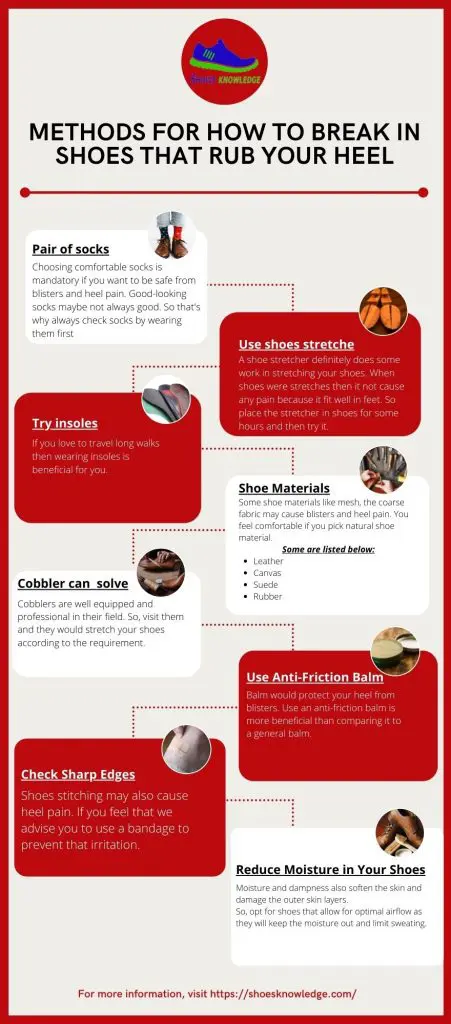
Remember the Right Approach
No matter what approach you decide to take when buying new shoes, it's important to remember one thing: always try them on with the socks you'll be wearing them with. This will give you a much better idea of whether they'll be comfortable or not, and if they need any extra cushioning. Also, make sure to time your purchase around the time of year when your feet are their smallest—shoes that are a size too big in the winter might not be as bad as you think!
FAQS about: How to break in shoes that rub your heel
Does Vaseline stop shoes rubbing?
When you buy new shoes, they may rub against your heel. This can cause blisters and soreness. One way to reduce this is by applying Vaseline around the back of the shoe where it hits your foot. Do this before putting on socks.
What are socks/shoe materials best for preventing blisters?
If you are choosing new shoes, select ones which are made of padded materials. If the material is too rough on your feet or rubs against them, Vaseline can be used to lessen friction between your foot and the shoe.
How do you stop new shoes from giving you blisters?
When buying new shoes it's important to break them in before wearing them for long periods of time. One way to do this is by using a shoe stretcher. Another way is to wear them around the house for short periods of time, then increase the time you spend wearing them as your feet get used to the new shoes.
Why do new shoes hurt?
Shoes that are new and stiff can rub against your feet, which can cause blisters. The best way to prevent this is by breaking them in gradually before wearing them for long periods of time. Applying Vaseline can also help to reduce friction. If you experience pain when wearing new shoes, stop immediately and try the methods listed above to make them more comfortable.
Hey there, I’m Jack Jiff, founder and editor in chief here at smartliter.com. After my best friend spent hundreds of hours trying to convince me, I decided to take control of my life and finally got to make this site. I’m on a mission to share my insider tips with every man who has a skilled trade job

